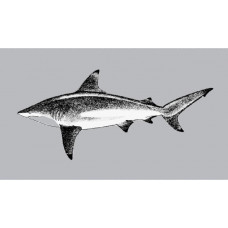Latin name
Carcharhinus amblyrhynchoides
Other name
Queensland shark
Identification
The body is barrel-shaped and streamlined. The muzzle is broad and short, wedge-shaped. The eyes are relatively large, with flashing membranes. There are five pairs of long gill slits. The teeth have a single narrow tip and serrated edges; the anterior teeth are more symmetrical, the posterior teeth are curved backwards. The lower teeth are slightly straighter and thinner than the upper teeth. There are 31-33 rows of teeth in the upper jaw and 29-33 in the lower jaw.
Features of fish fins
This species of shark has one anal fin and two dorsal fins. The first dorsal fin is approximately level with the pectoral fins and is triangular in shape. The pectoral fins are large, crescent-shaped with rounded or pointed ends.
Fish colouring
The back is bronze with a white belly. The tips of the pectoral fins, both dorsal fins and the top of the tail are black. White stripes are clearly visible on the sides of the shark which fade with age.
Distribution
Widespread in the waters of the Indian Ocean and south-western border regions of the Pacific Ocean from the Gulf of Aden and the coast of India to Indonesia, Vietnam, the Philippines and the northern coast of Australia.
Habitat
Pelagic species. They live in coastal waters, and in rare cases can be found far from the coast, at depths of up to 50 metres.
Size
Fish with a body length of up to 170 centimetres, while the average size is between 130 and 150 centimetres.
Behavior
Graceful sharks can swim in groups or alone.
Food and feeding habits
They are predators and feed on a variety of fish, cephalopods and crustaceans.
Reproduction
The graceful shark is a viviparous species. Females usually give birth to up to three pups. They reach maturity at a length of 110-115 centimetres.
Fishing
They are occasionally caught as by-catch in gillnets and longlines in commercial fisheries in Thai, Indian and Sri Lankan waters.
Relationship with a person
Traumatogenic. Because of their large size, sharks of this species are considered potentially dangerous to humans, although no attacks have been recorded. Their meat is eaten fresh and dried, their fins are exported to Asian markets and their liver fat is used to make vitamins.
| Classification | |
| Phylum | Chordata |
| Class | Chondrichthyes |
| Squad | Carcharhiniformes |
| Family | Carcharhinidae |
| Genus | Carcharhinus |
| Species | C. amblyrhynchoides |
| Features | |
| Conservation status | Vulnerable |
| Habitat | Pelagic |
| Life span, years | No information |
| Maximum body weight, kg | No information |
| Maximum length, cm | 170 |
| Sailing speed, m/s | No information |
| Threat to people | Edible |
| Way of eating | Predator |
Graceful shark
Tags: graceful shark


